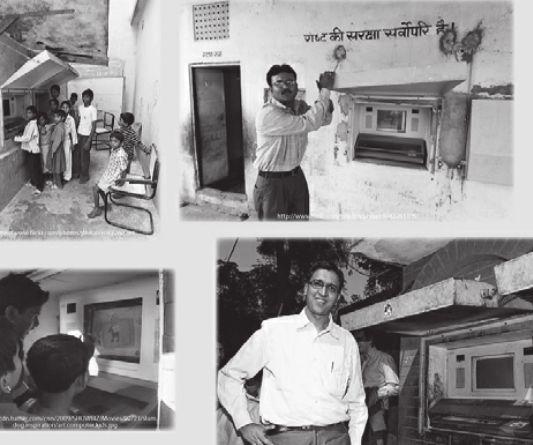用“云”建一所未来的学校
2013-07-17bySugataMitra
by Sugata Mitra



本文作者苏伽特·米特拉是英国纽卡斯尔大学教育、交流和语言科学学院的一位教育技术教授。他因自己的教育实验——“墙中洞”,而为人所熟识。他是NIIT(National Institute of Information Technology,印度国家信息技术学院)荣誉退休的首席科学家,并凭借“墙中洞”实验项目成为2013年TED大奖的获得者。TED是“Technology, Entertainment, Design”的缩写,是美国一家私有非营利机构,该机构以其组织的TED演讲大会而闻名,会议宗旨为“用思想的力量来改变世界”。 TED大奖设立于2005年,每年的三位获奖者除了得到十万美金外,还有机会在TED会议上公开阐述自己的TED愿望,而TED的组织者将竭尽全力帮助其实现愿望。
What is going to be the future of learning? The kind of learning we do in schools today originated about 300 years ago, from “The British Empire”. Imagine trying to run the entire planet, without computers, without telephones, using handwritten pieces of paper, traveling by ships. But 1)the Victorians actually created a global computer made up of people. They made another machine to produce those people: the school. Schools produced people who 2)were identical to each other. They engineered a system so robust that its still with us today, continuously producing identical people for a machine that no longer exists. How is present-day schooling going to prepare children for the future?
Well, I 3)bumped into this whole thing completely by accident...
I used to teach people how to write computer programs in New Delhi. Right next to where I used to work, there was a slum with many orphaned children. We also had some rich parents with computers, who used to tell me about how gifted their children are. I suddenly figured that, How come all rich people have these extraordinarily gifted children? What did the poor do wrong?
I soon made a hole in the boundary wall of that 4)slum, and stuck a computer inside just to see what would happen. All the children came running in. They said, “What is this? Can we touch it?”I said, “If you wish to...” Then I went away, and eight hours later, found them browsing and teaching each other how to browse. My colleagues said, “One of your students must have showed them how to use the mouse.” So I repeated the experiment, this time 300 miles out of Delhi, in a remote village, where the chances of a passing software development engineer were very slim. So I stuck my computer in and went on my away. After a couple of months, I returned to find kids playing games on it. They said, “We want a faster processor and a better mouse.” So I said, 5)“How on Earth do you know all this?” And they said, in an irritated voice, “Youve given us a machine that works only in English, so we had to teach ourselves English in order to use it.” Thats the first time, as a teacher, I had heard the words “teach ourselves” said so 6)casually.
I repeated the same experiment, over and over, with the same results every time. So I decided to destroy my own argument by making a ridiculous 7)hypothesis. Can children in a remote south Indian village learn the biotechnology of DNA replication, in English, from a street-side computer? I figured the experiment would fail a few times, at which point I could go back to the lab and say, “we need teachers.”
I put the Hole in the Wall computers in a village called Kallikuppam, and downloaded plenty of stuff about DNA replication before I left. I came back a few months later, and the children said,“Weve understood nothing.” It was as I expected... Then a little girl raised her hand, and says in broken 8)Tamil and English, “Well, apart from the fact that improper replication of the DNA 9)molecule causes disease, we havent understood anything else.”
未来的学习会是怎样的呢?现今我们在学校中的学习模式起源于大概300年前,源自“大英帝国”。想象一下在没有电脑,没有电话,只有手写纸张和航运的情况下试图操纵局势,运转整个星球,那是什么样子的。但是维多利亚时代的人真的用人创造了一台全球计算机。他们制造了另一机器去培养那些人:学校。学校制造出类似的人。他们设计了一个强大的系统,强大到至今我们仍走不出这个体系,继续为这不再存在的机器培养着相同的人。现今的教育要为未来培养出怎样的孩子呢?
好了,我触碰到这个关于未来教育的议题完全是意外……
我曾在新德里教人如何编写计算机程序。恰巧在我工作地点附近,有一个住着许多孤儿的贫民窟。我们也认识一些能给孩子用上电脑的有钱家长,他们过去常常跟我说他们的孩子多有才。我突然间想,为什么所有有钱人都拥有这些天赋异禀的孩子呢?穷人家做错了什么?
不久后,我在贫民窟的边界墙边挖了一个洞,而后在里面装了一台电脑,就想看看会发生什么事。所有的孩子都跑了进来。他们问道:“这是什么?我们能摸摸么?”我说:“随你喜欢……”然后我走开了,八个小时以后,我发现他们正在浏览信息并互相教对方如何浏览信息。我的同事说:“肯定是你的其中一个学生教他们怎么用鼠标了。”所以我又重置了一次实验,这次是在离德里300英里外的地方,一个偏僻的村庄,在那里,软件开发工程师路过的机率很小。我安装好电脑之后,便走开了。几个月过去了,我回来后发现孩子们在电脑上玩游戏。他们说:“我们想要一个更快的处理器和更好的鼠标。”我就问:“你们到底是怎么知道这些的?”然后他们就忿忿地说道:“你给了我们一台只能用英语操作的机器,所以为了使用它,我们不得不去自学英语。”这是第一次,作为一个老师,我听到“自学”这个词儿被如此随意地说出来。
我重复了相同的实验,一遍又一遍,每次都会有相同的结果。于是我决定建立一个荒谬的命题来打破自己的论点。在偏远的印度南部村庄的孩子们能从街边的电脑上用英语学会DNA复制的生物技术吗?我设想过这个实验会遭遇几次失败,这样的话,我会回到实验室并且说:“我们需要老师。”
我把“墙洞”电脑安装在一个叫作“卡里古帕”的村庄里,并在我离开前下载了大量关于DNA复制的材料。几个月后我回来了,孩子们说:“我们什么都不懂。”这如我所预期的一样……然后一个小女孩举起了自己的手,用她蹩脚的泰米尔语和英语对我说:“是的,我们知道DNA分子的错误复制会导致疾病,除此之外,我们不明白其他任何东西。”
It was an educational impossibility. They tested at zero to 30 percent, after two months, in tropical heat, with a computer under the tree, in a language they didnt know, doing something a decade ahead of their time. Absurd! But 30 percent is a fail, in Victorian terms. We needed 20 percent higher, and I couldnt find a teacher. But I did find a 22-yearold girl who was an accountant and played with the kids all the time. I asked her, “Can you help them?” She said, “Absolutely Not.” So I suggested she use the grandmother method;“Stand behind them. Whenever they do anything, just say, ‘Well, wow, how did you do that? Whats the next page? Gosh, when I was your age... You know what grannies do.” After two months, the scores jumped to 50 percent. Kallikuppam had caught up with my control school in New Delhi, a rich private school with a trained biotechnology teacher. Now I knew how to level the playing field.
这是教育范畴上不可能的事情。在热带酷热的环境下,用一台在树下的电脑,用他们不懂的语言,超前学习十年后才会学到的东西,用两个月的时间,从0分涨到了30分。太荒谬了!但是以维多利亚时代的规范来说,30分是失败的。我们需要再提高20分,然而我找不到一个老师。但我找到一个22岁做会计的女孩儿,她总和那些孩子一起玩。我问她:“你能帮助他们吗?”她回答说:“绝对不行。”之后我建议她使用老奶奶的方法;“站在他们背后。无论他们做什么,你只需要说:‘哇,喔,你是怎么做到的?下一步要做什么?天啊,当我像你这么大的时候……你知道这就是老奶奶们干的事儿。”两个月之后,分数涨到了50。卡里古帕村赶上了我在新德里那所用来对照实验的学校,那是所富人就读的私立学校,有训练有素的生物老师。如今我知道如何大展拳脚了。
小链接
Hole in the Wall “墙中洞”项目
1999年,“墙中洞”项目(Hole in the Wall,简称为HIW)作为一个针对于孩子学习的教育实验首次启动。起初,一台电脑被安放在德里Kalkaji贫民窟的一面墙亭里,孩子们可以免费使用这台电脑。这个教育实验的目的是要证明在没有任何正规训练的情况下,孩子们可以通过电脑轻松学习。苏伽特称这种学习为凿壁上网教育计划。这个实验在多地进行,在印度郊区有40多个“墙中洞”项目。2004年,柬埔寨也进行了这个实验。“墙中洞”项目的兴趣点包括教育、远程展示、自发组织体系、认知体系、自然科学和意识。
“墙中洞”实验项目在流行文化里也留下了深刻烙印。印度小说作家兼外交官维卡斯·史瓦卢普读了有关苏伽特实验的报道后,有感而发,创作了小说处女作《Q&A;》,随后被改编为奥斯卡金像奖获奖电影《贫民窟的百万富翁》。
There is evidence from 10)neuroscience. The center of our brain, when its threatened, it shuts down everything else. Punishment and examinations are seen as threats. So we basically make our children shut their brains down, and then we say, “Perform.” We need to look at learning as the product of educational selforganization. The teacher sets the process in motion and then stands back 11)in awe and watches as learning happens. My wish is to build these Self-Organized Learning Environments; design a future of learning by supporting children all over the world to tap into their wonder and their ability to work together. Help me build this school. It will be called the School in the Cloud, where children go on these intellectual adventures driven by lifes big questions.
Plus, you can also do Self-Organized Learning Environments at home, in school, outside school, in clubs. Its very easy to do. Theres a great document produced by TED which will tell you how to do it. Please do it across all five continents and send me the data, then Ill put it all together, move it into the School of Clouds, and create the future of learning. Thats my wish.
And just one last thing. At the top of the Himalayas, at 12,000 feet, where the air is thin, I once built two Hole in the Wall computers, and the children flocked there. And there was this little girl who was following me around. I said to her,“You know, I want to give a computer to everybody, every child. I dont know, what should I do?” She suddenly raised her hand, and said to me, “Get on with it.” I think it was good advice. Ill follow her advice.
神经学上有支持的证据。我们的大脑中枢在受到威胁的时候会关闭一切功能。惩罚和考试被视为威胁。所以基本上,我们是令孩子关闭了他们的大脑后再命令其“运作”。我们需要将学习视为自发式教育的产物。老师在初始时设定进程,然后以敬畏的姿势退到一旁,观察学习的发生。我的愿望是建立这种“自发组织的学习环境”;设计一种未来的学习模式,给世界各地的孩子们提供支持,帮助他们满足好奇心并挖掘他们团队合作的能力。帮助我建立这所学校吧。它将被称为“云学校”,在那儿,孩子们在人生难题的驱使下继续这些智力旅程。
另外,你可以在家,在学校,在校外,在社团里,组织自我学习。这很容易做到。TED制作过一部很棒的纪录片,将告诉你如何去做。请把这个信息带到世界各地,并把数据发给我,然后我会将其组合在一起,放进云学校,创造未来的学习模式。这就是我的愿望。
最后一件事情。在喜马拉雅山的顶端,在12,000英尺的高空,那里空气稀薄,我曾置放了两台“墙洞”电脑,孩子们聚集在那里。而后有个小女孩跟着我转。我对她说:“你知道吧,我想给大家每人,每个孩子一台电脑。我不知道,我应该做点什么?”她突然伸出自己的手(向我要电脑),对我说:“行动起来呀。”我认为这是很好的建议。我会听从她的建议。
